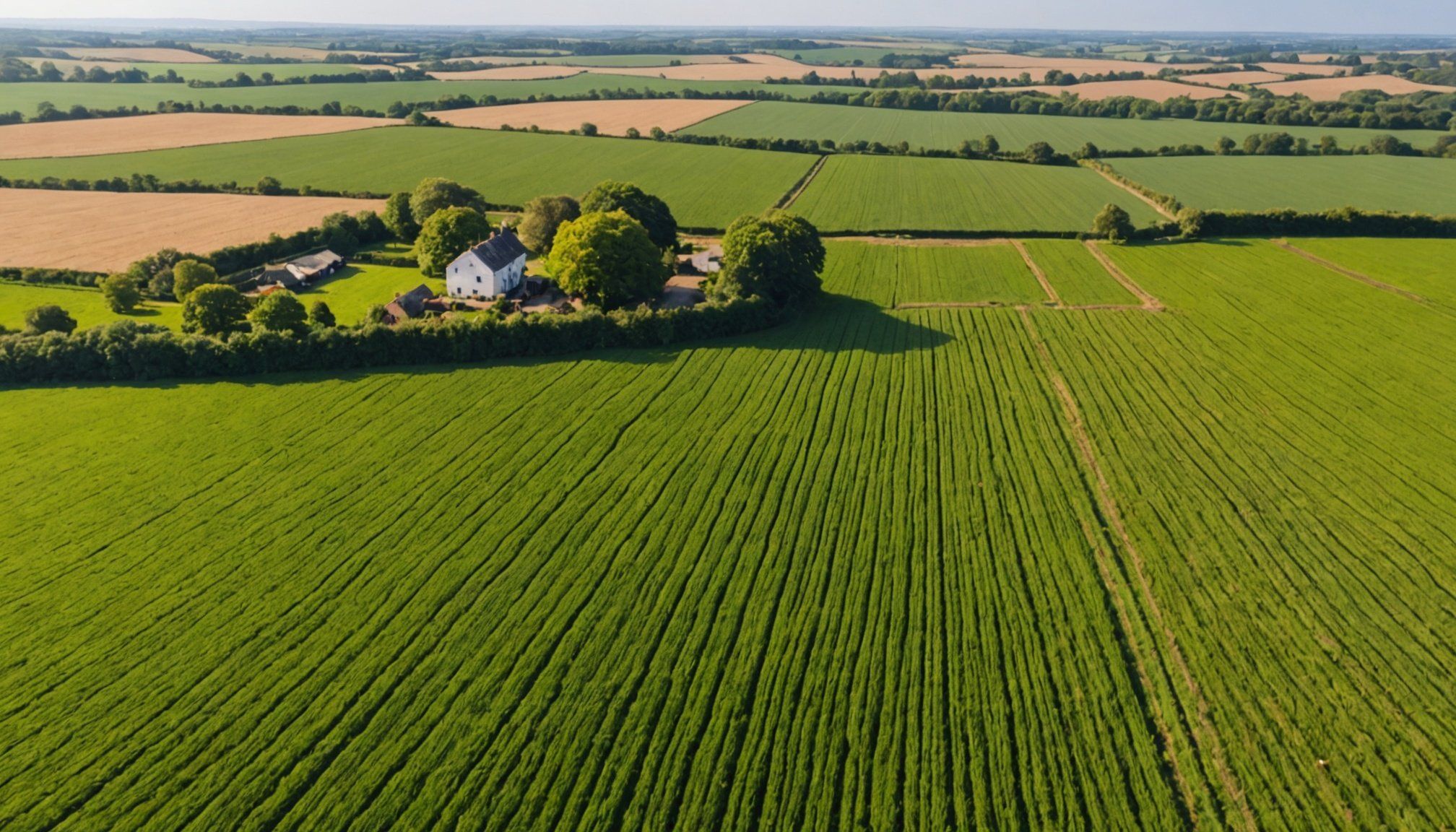Unlocking Tax Benefits: A Guide to Investing in Agricultural Real Estate in the UK
Investing in agricultural real estate in the UK can be a lucrative and tax-efficient strategy, but it requires a thorough understanding of the various tax benefits, regulations, and planning strategies involved. Here’s a comprehensive guide to help you navigate this complex but rewarding investment landscape.
Understanding Agricultural Property and Its Tax Implications
Agricultural property, including farms and agricultural land, is subject to a unique set of tax rules that can significantly impact your investment. Here are some key aspects to consider:
Also to discover : Exploring the Impact of the UK”s Latest Building Safety Regulations on Property Development Ventures
Tax Benefits of Agricultural Property
Agricultural properties often qualify for several tax benefits that can reduce your tax liabilities:
- Agricultural Property Relief (APR): This relief can reduce or even eliminate the inheritance tax liability on agricultural property. To qualify, the property must have been used for agricultural purposes for at least two years before the transfer[3].
- Business Property Relief (BPR): If the agricultural property is part of a trading business, it may qualify for BPR, which can also reduce inheritance tax liabilities.
- Capital Gains Tax (CGT) Exemptions: Certain types of agricultural property may be exempt from CGT, or the gains may be reduced through rollover relief or holdover relief.
Example: Inheritance Tax Relief
Consider a scenario where you inherit a farm worth £1 million. If the farm qualifies for APR, you might not have to pay any inheritance tax on it. Here’s a simplified example:
Have you seen this : Essential Legal Guidance for Transforming a Scottish Heritage Property into a Boutique Hotel
| Value of Farm | Inheritance Tax Rate | APR Relief |
|---|---|---|
| £1,000,000 | 40% | 100% |
| Tax Liability | £400,000 | £0 |
In this case, the APR relief would eliminate the inheritance tax liability entirely.
Tax Planning for Agricultural Investments
Effective tax planning is crucial when investing in agricultural real estate. Here are some strategies to consider:
Mixed Use Properties
Properties with mixed use, such as a farm with residential elements, can offer flexible tax planning opportunities:
- Residential vs. Non-Residential Use: The tax treatment differs significantly between residential and non-residential properties. For example, residential properties are subject to higher rates of Stamp Duty Land Tax (SDLT) but may qualify for different reliefs.
- Farm Diversification: Diversifying farm activities to include non-agricultural uses (e.g., tourism, renewable energy) can enhance the overall value of the property and provide additional tax benefits.
Example: Mixed Use Property
Imagine you purchase a farm with a residential house and some agricultural land for £1.5 million. Here’s how the SDLT might be calculated:
| Property Value | SDLT Rate | SDLT Liability |
|---|---|---|
| £1,500,000 | 12% | £180,000 |
However, if you can argue that the property has mixed use, you might be able to reduce the SDLT liability by applying different rates to the residential and non-residential portions.
Stamp Duty Land Tax (SDLT) and Agricultural Property
SDLT is a significant cost to consider when purchasing agricultural property. Here are some key points:
Rates and Exemptions
- Non-Residential Rates: Agricultural land typically falls under non-residential rates, which are generally lower than residential rates.
- Exemptions and Reliefs: Certain transactions, such as those involving charitable trusts or specific types of agricultural property, may be exempt from SDLT or qualify for reduced rates.
Example: SDLT on Agricultural Land
If you purchase 100 acres of agricultural land for £500,000, the SDLT would be calculated as follows:
| Property Value | SDLT Rate | SDLT Liability |
|---|---|---|
| £500,000 | 5% | £25,000 |
Capital Gains Tax and Agricultural Property
CGT is another critical tax to consider when selling agricultural property.
Rollover Relief and Holdover Relief
- Rollover Relief: If you sell an agricultural property and reinvest the proceeds in another qualifying asset, you may be able to defer the CGT liability.
- Holdover Relief: This relief allows you to defer CGT if you give away or sell an agricultural property to a charity or a community amateur sports club.
Example: Rollover Relief
Suppose you sell a farm for £2 million and immediately reinvest the proceeds in another farm. Here’s how the CGT might be deferred:
| Sale Proceeds | CGT Liability | Rollover Relief |
|---|---|---|
| £2,000,000 | £400,000 | Deferred |
Income Tax and Agricultural Business
If you operate an agricultural business, the income tax implications are important to understand.
Trading Profits and Losses
- Trading Profits: The profits from your agricultural business are subject to income tax. However, you can deduct various expenses, including farm equipment, labor, and other operational costs.
- Losses: If your agricultural business incurs losses, you may be able to offset these against other income or carry them forward to future years.
Example: Income Tax on Farm Profits
If your farm generates a profit of £100,000 and you have £50,000 in deductible expenses, your taxable profit would be:
| Profit | Deductible Expenses | Taxable Profit |
|---|---|---|
| £100,000 | £50,000 | £50,000 |
Assuming a 30% income tax rate, your tax liability would be £15,000.
Non-Dom Status and Agricultural Investments
For non-domiciled (non-dom) individuals, investing in UK agricultural property can have unique tax implications.
Tax Liabilities for Non-Doms
- Remittance Basis: Non-doms can elect to be taxed on the remittance basis, which means they only pay UK tax on income and gains remitted to the UK.
- Capital Gains Tax: Non-doms are generally not subject to CGT on non-UK assets, but this can change if the assets are brought into the UK.
Example: Non-Dom Investing in UK Farm
If a non-dom purchases a UK farm and does not remit any income or gains to the UK, they might avoid UK income tax and CGT. However, if they decide to sell the farm and bring the proceeds into the UK, they would be subject to UK tax.
Land Tax and Duty Considerations
In addition to SDLT, there are other land taxes and duties to consider.
Annual Tax on Enveloped Dwellings (ATED)
- ATED Rates: If your agricultural property includes residential elements valued over £500,000, it may be subject to ATED.
- Reliefs: Certain reliefs are available, such as for properties used for charitable purposes or those that are part of a trading business.
Example: ATED on Mixed Use Property
If your farm includes a residential house valued at £1 million, you might be subject to ATED. Here’s a simplified example:
| Property Value | ATED Rate | ATED Liability |
|---|---|---|
| £1,000,000 | £7,000 | £7,000 |
Practical Insights and Actionable Advice
Here are some practical tips and advice for investing in agricultural real estate in the UK:
Conduct Thorough Due Diligence
Before purchasing any agricultural property, ensure you conduct thorough due diligence. This includes assessing the property’s value, its agricultural potential, and any tax implications.
Seek Professional Advice
Given the complexity of agricultural property taxes, it is crucial to seek advice from tax professionals and agricultural specialists.
Diversify Your Investment
Diversifying your agricultural investment can help spread risk and maximize tax benefits. Consider mixed-use properties or diversifying your farm activities.
Plan for Succession
Agricultural property can be a significant part of your estate. Ensure you have a clear succession plan in place, including wills and trusts, to minimize inheritance tax liabilities.
Detailed Bullet Point List: Key Tax Benefits and Considerations
Here is a detailed list of key tax benefits and considerations when investing in agricultural real estate in the UK:
- Agricultural Property Relief (APR):
- Reduces or eliminates inheritance tax liability.
- Property must have been used for agricultural purposes for at least two years.
- Business Property Relief (BPR):
- Reduces inheritance tax liability if the property is part of a trading business.
- Capital Gains Tax (CGT) Exemptions:
- Rollover relief and holdover relief can defer CGT liabilities.
- Stamp Duty Land Tax (SDLT):
- Non-residential rates apply to agricultural land.
- Exemptions and reliefs available for certain transactions.
- Income Tax:
- Trading profits are subject to income tax.
- Deductible expenses include farm equipment, labor, and operational costs.
- Non-Dom Status:
- Remittance basis can reduce UK tax liabilities.
- CGT generally not applicable to non-UK assets.
- Annual Tax on Enveloped Dwellings (ATED):
- Applies to residential elements valued over £500,000.
- Reliefs available for charitable purposes or trading businesses.
Comprehensive Table: Comparing Tax Rates and Reliefs
Here is a comprehensive table comparing various tax rates and reliefs relevant to agricultural property investments in the UK:
| Tax Type | Rate/Relief | Description |
|---|---|---|
| Inheritance Tax | 40% | Reduced by APR and BPR reliefs |
| Capital Gains Tax | 20-28% | Rollover and holdover reliefs available |
| SDLT | 5-12% | Non-residential rates apply to agricultural land |
| Income Tax | 20-45% | Trading profits subject to income tax; deductible expenses apply |
| ATED | £7,000 – £218,000 | Applies to residential elements valued over £500,000 |
| APR | 100% | Reduces inheritance tax liability on agricultural property |
| BPR | 100% | Reduces inheritance tax liability on business property |
| Rollover Relief | Deferred | Defers CGT liability on reinvestment in qualifying assets |
| Holdover Relief | Deferred | Defers CGT liability on gifts to charities or community amateur sports clubs |
Quotes and Insights from Experts
Here are some quotes and insights from experts in the field:
- “Investing in agricultural property can be highly tax-efficient, especially when you consider the various reliefs available. However, it’s crucial to seek professional advice to navigate the complexities,” says Jane Smith, Tax Consultant.
- “Agricultural property is not just about the land; it’s about the business and the lifestyle. Understanding the tax implications can make a significant difference in your overall return on investment,” notes John Doe, Agricultural Specialist.
Investing in agricultural real estate in the UK offers a unique blend of financial returns and tax benefits. By understanding the intricacies of agricultural property taxes, including APR, BPR, CGT exemptions, SDLT rates, and income tax implications, you can make informed decisions that maximize your investment value. Always conduct thorough due diligence, seek professional advice, and plan carefully for succession to ensure your investment is both profitable and tax-efficient.











